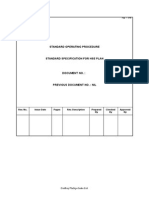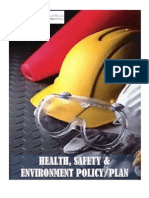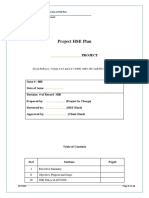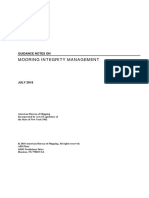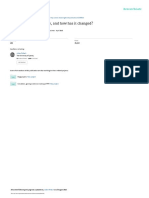HSE Plan Format
HSE Plan Format
Uploaded by
Albert LuckyCopyright:
Available Formats
HSE Plan Format
HSE Plan Format
Uploaded by
Albert LuckyOriginal Description:
Copyright
Available Formats
Share this document
Did you find this document useful?
Is this content inappropriate?
Copyright:
Available Formats
HSE Plan Format
HSE Plan Format
Uploaded by
Albert LuckyCopyright:
Available Formats
HSE PLAN
Construction and Installation Phases
ABSTRACT
This document comprises Health, Safety and Environmental (HSE) Plan for the activities foreseen
during the Construction and Installation Phases of the development of Baltim North Project in
Mediterranean Sea (Egypt) Project.
Objective of the document is to identify the activities necessary to control and manage all health,
safety and environmental issues.
1
0
REV
Issue for Approval
Issue for comment
Description
Prepared
Checked
Approved
19/03/04
18/02/04
Date
CONTENTS
1.
INTRODUCTION ............................................................................ 3
1.1
SCOPE AND APPLICATION OF WORK ................................................... 3
1.2
FIELD DEVELOPMENT OVERVIEW ........................................................ 4
2.
HSE POLICY AND STRATEGIC OBJECTIVES ..................................... 4
2.1
HSE POLICY STATEMENT ................................................................... 4
2.2
HSE PROJECT OBJECTIVES ................................................................ 4
3.
APPLICABLE LAWS, CODES AND STANDARDS ................................. 6
4.
ORGANIZATION, RESPONSIBILITIES, RESOURCES ......................... 6
4.1
PROJECT ORGANIZATION AND RESPONSIBILITY ................................... 6
4.2
PROCUREMENT AND CONTRACTORS ................................................... 7
5.
RISK MANAGEMENT....................................................................... 8
5.1
METHODS AND PROCEDURES FOR HAZARDS IDENTIFICATION, RISK
EVALUATION AND MANAGEMENT ........................................................ 8
5.2
ENVIRONMENTAL ANALYSIS .............................................................. 9
Proc. 1.3.1.17 Attachment 1
Page 1 of 15
5.3
OCCUPATIONAL HEALTH ................................................................... 9
6.
HSE ACTIVITIES .......................................................................... 10
7.
INTERFACES AND COMMUNICATION ............................................ 10
8.
AUDIT ......................................................................................... 11
9.
CONTINGENCY AND EMERGENCY RESPONSE ................................ 11
10.
INCIDENT/NEAR MISSES INVESTIGATION ................................... 11
11.
ATTACHEMENT 1 PETROBEL HSE POLICY..
12.
ATTACHEMENT 2 - PROJECT ORGANIZATION CHART.
13.
ATTACHEMENT 3 - RISK MANAGEMENT ACTION PLAN .
1.
INTRODUCTION
1.1
SCOPE AND APPLICATION OF WORK
This document comprises Health, Safety and Environmental (HSE) Plan
for the activities foreseen during the Construction and Installation
Phases of the development of Baltim North Concession in Mediterranean
Sea (Egypt).
The PETROBEL HSE Integrated Management System will be implemented
throughout the HSE Plan to ensure a systematic, consistent and
integrated approach towards HSE aspects. The HSE Plan will provide a
structured approach that addresses HSE aspects of the Project throughout
the Construction and Installation phases. This will primarily include the
identification of safety and environmental critical elements.
This document:
includes the PETROBEL HSE Policy statements;
outlines the HSE Project objectives;
outlines the programme and addresses the actions necessary to
achieve the HSE objectives which ensure the HSE aspects of the
Project are managed in an adequate and proper manner;
The HSE Plan will be reviewed, revised and updated at each start of a new
project phase and whenever there is a major change in the Company
Policies and requirements, or modifications to Company HSE objectives.
In case of conflict, documents hierarchy is:
1. PETROBEL HSE Policy
2. Project procedures
3. Applicable Guidelines
1.2
FIELD DEVELOPMENT OVERVIEW
Baltim North field will be developed through a production platform with
four legs in 73 meter water depth. The platform will accommodate 5 wells
producing gas with associated condensates for a total average daily
production of 5 MSCMD gas and 5000 BPD condensates; such production
after separation of associated water from gas will be delivered in
multiphase to the existing platform of Baltim East through a subsea
pipelines of 18 diameter and 21 Km length. Another sealine of 4 will
transport produced water. The production from Baltim North commingled
with the one from Baltim East will be delivered onshore to an existing
plant at Abu Madi for final gas conditioning and condensate stabilization
The platform is designed according to the RULE (reliable, unattended, low
energy) concept and is unmanned with minimum treatment facilities.
2.
HSE POLICY AND STRATEGIC OBJECTIVES
2.1
HSE POLICY STATEMENT
PETROBEL has formalized a Health, Safety and Environment (HSE)
Integrated Policy. PETROBEL Integrated Management System refers to
ISO 14001 requirements for Environmental Management System, and to
OHSAS 18001 specifications for Occupational Health and Safety
Management System.
The Baltim North Project, for the Construction and Installation Phases,
refers to the PETROBEL HSE Policy showed in the Attachement 1.
The policy is implemented through the following commitments:
All activities will comply with legal and regulatory health, safety and
environmental requirements, as a minimum.
Health, safety and environmental protection are the responsibility of
the line manager and supervisor in charge of the work.
Everyone will know and comply with the mandatory rules, including
stopping unsafe work.
Everyone will search for continual improvement in health, safety
and environmental protection.
Contractors will follow the same principles as PETROBEL in support
of the shared targets.
2.2
HSE PROJECT OBJECTIVES
Project HSE Objectives for Construction and Installation Phases are:
Avoid any accidents and injury during construction and installation,
implementing the best project and operating procedures from HSE
point of view in compliance with economical and technical
requirements;
Motivating personnel at all levels on HSE issues and communicating
clear commitments.
The HSE activities within this plan have the following objectives:
Establish, implement and maintain an effective HSE Integrated
Management System throughout the project lifecycle.
Demonstrate compliance with HSE policy and work within the
PETROBEL HSE Integrated Management System.
Ensure Contractor, Sub-contractor and Vendor HSE Management
systems are compatible with those of PETROBEL.
Ensure compliance with International and Egyptian Health, Safety
and Environmental legislation, codes and standards.
Manage risk in construction, installation, commissioning, drilling,
operational and maintenance activities.
Ensure that appropriate levels of competencies for all persons
engaged in performing HSE critical tasks are established and
provide training where necessary.
Ensure that all possibilities of occupational exposure to health
hazards to personnel are kept to a minimum and that any identified
risks will be given a priority to mitigate risks ensuring employees
health at work.
Ascertain any potential health impact of construction and
installation operations on the neighbouring environment and to
ensure that these are minimised.
Ensure a full inventory of all emissions, wastes and discharges is
maintained and that all wastes are disposed of in a manner that is
acceptable from an environmental and regulatory standpoint.
3.
APPLICABLE LAWS, CODES AND STANDARDS
The activities of the project are in conformals with the applicable laws and
HSE codes/standards and appropriate authorization given by Egyptian
Authorities.
Recognised standards are applied in the execution of the project.
The standards applied by the Contractors must be in agreement with
Company Standards.
Project Team ensure that the requirements of the rules and standards are
accounted in the design premises, in the operating and surveillance
procedures.
4.
ORGANIZATION, RESPONSIBILITIES, RESOURCES
Job and role description, including assignments of responsibility and
authority, are clearly defined and consistent to the relevant position in the
Project organization.
Previous projects experiences have been used for selecting the most
appropriate organizational structure.
4.1
PROJECT ORGANIZATION AND RESPONSIBILITY
The Project organizational structure is designed to encourage effective
and efficient communication and cooperation between all participants in
the project.
Project organization for the Construction and installation Phases is
outlined in the organization chart (nominative chart) included in
Attachement 2
The specific organisation and responsibilities for managing HSE aspects
are identified in the following.
Project Manager
He is responsible for performance compliance with the HSE policies, by:
implementing the HSE Policy for the Project;
ensuring
definition
of
roles,
responsibilities,
authorities,
accountabilities and interrelations of staff in implementing the
Project HSE Plan;
ensuring monitoring of the HSE activities;
activating and implementing appropriate actions to guarantee the
defined HSE objectives, when necessary.
HSE General Manager
He provides the following tasks:
assists the PM, planning, supporting and co-ordinating the HSE
related activities;
ensures management of the documentation and HSE records;
ensures application of the HSE Plan and monitoring of HSE
performance to Contractors.
Project Team
They are responsible for implementing the HSE Plan and the HSE matters
within their authority and area of responsibility.
Personnel involved in the project are competent for the execution of the
job assigned and adequately trained.
Specific needs of training for personnel will be identified (e.g. prior to the
execution of hazardous operations, emergency situation) and specific HSE
training will be given to personnel to ensure problem understanding,
involved risks, expected behaviour.
4.2
PROCUREMENT AND CONTRACTORS
The project organization establishes effective and efficient processes to:
Establish criteria for selection, evaluation and control of contractors
and sub contractors;
Identify and schedule the product/service that will be purchased
and methods to verify purchased products/services (tests,
inspection etc. if any)
Define modalities for inspections and tests that have to be executed
on delivered products/services
Each Contractor will carry out an HSE Plan for its activities; this document
will comply with the Company HSE Plan.
Comment [ES1]:
5.
RISK MANAGEMENT
The Risk Management process will be applied during the construction and
installation phases of the development of the Project to achieve the
following:
Systematically identify hazards, threats and potential hazardous
events
Identify activities that can release the hazard
Determine how likely is it to occur
Evaluate (assess) the risks against PETROBEL assessment criteria
Record the significant hazards and effects
Document the findings
Implement suitable risk reduction measures (prevent, control and
mitigate)
Determine if the hazard can be eliminated or controlled
Reduce the probability of occurrence
Reduce the consequences
Determine what measures are required if the hazard occurs
During the following phases of the Project a qualitative assessments of
identified significant risks to identify areas for potential risk reduction
and/or where mitigation measures need to be assessed shall be carried
out. Residual events will be assessed against defined Risk Screening and
assessment Procedure (Doc. HSE-IMS Procedure No 2 )
5.1
METHODS AND PROCEDURES FOR HAZARDS IDENTIFICATION,
RISK EVALUATION AND MANAGEMENT
Hazard will be identified and assessed using the following tools and
techniques:
Experience from previous experiences,
Use of checklists and accident statistics;
Codes and standards;
The selection of the appropriate hazard identification and risk evaluation
tools and techniques should depend upon the nature and scale of the
installation, the information available, the phase of the project and
experience of similar installations.
The emphasis at the Construction and Installation phases are on
minimising HSE risks by adopting, where practicable at this stage, by
careful design and implement operating procedures.
For Construction and Installation Phases has been held a brainstorming
dated 17th of February 2004 to map the Risk Register, each discipline
attended it was in charge of analyzing the risks related to his/her
competence area for the Construction/Installation Phase of the Project.
Following a Risk Management Plan for Baltim North an Action Plan
has been finalized to mitigate the risk evaluated (Attachement 3).
Management has reviewed the Risk Management Plan.
5.2
ENVIRONMENTAL ANALYSIS
Adequate knowledge of the environment in its present conditions and
forecast of the impact determined by the project activities represent the
basis for defining appropriate measures to minimise the impact.
An Environmental Impact Assessment of the environment conditions
prior to project implementation has been carried out to evaluate the
effects of the project activities on the environment and to define and
implement measures to minimize the impact.
5.3
OCCUPATIONAL HEALTH
Protect health and safety of the personnel working in the Project, in
connection with the activities assigned is a project target, which has been
catched through:
identification of risks for the health and safety of the personnel
working on the project, connected with the working environment
and to the specific activities
Define protection measures and Personal Protective Equipment
necessary for the different tasks
Ensure proper procedures and training are activated for personnel
to be aware of risks, of safety measures to adopt in the execution of
the tasks to remove or minimise risks
Ensure measures are implemented to intervene promptly in case of
injury to personnel, including provision of medical section on the
working sites, training of personnel to first aid, emergency actions
and appropriate facilities
6.
HSE ACTIVITIES
Project documents forwarded and operating procedures by the technical
disciplines are checked to verify that all HSE requirements, HSE design
criteria and recommendations from HSE studies have been correctly
implemented and the relevant aspects covered.
Existing Operating Procedures will be assessing to be fit for pourpose;
where it is required; other Operating Procedures will be developed and
implemented.
During SIMOPS operations particular care will be taken to identify risks
and managed them through Risks assessment and SIMOPS Procedures.
A systematic Management Walk Through will be implemented with
objective to identified the actions for continuos improvement of HSE
performance.
7.
INTERFACES AND COMMUNICATION
The Project Organization ensures an appropriate and effective
communication process for the project taking into account the needs of
the project organization.
An effective and systematic communication is to be established:
with Shareholders Representatives;
within the Project functions;
with Contractors;
The communication line and measures aim at ensuring:
awareness on HSE matters;
updated knowledge on HSE project issues;
co-ordination of HSE aspects among the different project functions
and with contractors;
efficient management of emergency situations;
good relationship and co-operation among people involved in the
project and with the population.
Formal arrangements in terms of Meetings and Monthly Reports will be
developed.
8.
AUDIT
The audit process acts as a management activity for independent
assessment of any designed process or activity. The audit process
provides an independent tool for use in obtaining objective evidence that
the existing requirements have been met, since the audit evaluates the
effectiveness and efficiency of the project.
Audit will be performed to assess:
Correct implementation of HSE Plan and Operating Procedures
Identification and compliance with project applicable codes and
standards requirements
Audit will be carried out in compliance with HSE Audit and Inspection
procedure (Doc. HSE-IMS Procedure No 03)
9.
CONTINGENCY AND EMERGENCY RESPONSE
Adequate preparation to react to foreseeable events shall be put in place.
The site location, during drilling and SIMOPS phases will have an
Emergency Response Plan, integrated with PETROBEL Emergency
Response Plan, which will be maintained, exercised regularly and
communicated to all personnel. Exercises and Drills will be held on a
regular basis and will cover realistic emergency scenarios, including all
aspects of contingency planning and response procedures. Where
necessary external bodies will be advised. Key personnel will be trained to
a level of competence appropriate to their responsibility in an emergency.
10.
INCIDENT/NEAR MISSES INVESTIGATION
The reporting and recording of any event altering normal conduction of
working activities, besides being a requirement prescribed by law
regulations, is an essential tool for the analysis of data related to accidents,
incidents and near-misses occurred, and for the evaluation of this
phenomena and their development over time; in particular, the study of
the data relevant to occurrence types and modes, enables to identify
structural and/or organizational weak areas, as well as to define
improvements or prevention measures enabling to prevent their
reoccurrence.
Project Team ensure that incidents and near misses will be though roughly
investigated and appropriate measure will be taken to avoid repetition of
events.
Incidents will be immediately notified to Company and personnel
supervises investigation on causes and application of measures defined
according to Company procedures Accident /Incidents reporting and
investigation.( Doc. HSE-IMS Procedure No 01)
11.
ATTACHEMENT 1 PETROBEL HSE POLICY
12.
ATTACHEMENT 2 PROJECT ORGANIZATION CHART
13.
ATTACHEMENT 3 RISK MANAGEMENT ACTION PLAN
You might also like
- Method Statement For Asphalt Paving WorksDocument5 pagesMethod Statement For Asphalt Paving WorksGokulakrishnan Govindarajan100% (1)
- Health, Safety, and Environment (HSE) Management PlanDocument5 pagesHealth, Safety, and Environment (HSE) Management PlanCarl Williams100% (4)
- SAMPLE HSE PlanDocument28 pagesSAMPLE HSE PlanRahmat Adi Saputra100% (9)
- Safety PlanDocument18 pagesSafety PlanSAFETY SHREEJI100% (4)
- Project HSE PlanDocument33 pagesProject HSE PlanWinnie Eldama100% (2)
- WHS Management PlanDocument16 pagesWHS Management PlanValentina BustosNo ratings yet
- 04 - Human Resource PlanDocument10 pages04 - Human Resource PlanMohammed AffrozeNo ratings yet
- Site Visitor Management PlanDocument8 pagesSite Visitor Management Planhanshul sisodiyaNo ratings yet
- Health and Safety Policy and ProceduresDocument58 pagesHealth and Safety Policy and ProcedureskafilussNo ratings yet
- Appendix B HSE Plan 2019Document1 pageAppendix B HSE Plan 2019aymenmoatazNo ratings yet
- Hse PlanDocument3 pagesHse Planresure100% (5)
- FIDIC Tendering Procedures: International Federation of Consulting EngineersDocument24 pagesFIDIC Tendering Procedures: International Federation of Consulting EngineersdinaquaNo ratings yet
- LMAD 3.1 Business RiskDocument15 pagesLMAD 3.1 Business RiskKuya Rimson Vlogs67% (3)
- Risk Assessment and Treatment ProcessDocument3 pagesRisk Assessment and Treatment ProcessManojNo ratings yet
- 08-Construction HSE Management PlanDocument19 pages08-Construction HSE Management PlanMian100% (1)
- Hse Management Plan IffDocument16 pagesHse Management Plan Iffmorgojoyo100% (1)
- Environment Management Plan P-04Document8 pagesEnvironment Management Plan P-04khurram shahzad0% (1)
- Gbemich Services: Health, Safety and Environmental Management Systems Plan For Construction of SNEPCO FACILITYDocument20 pagesGbemich Services: Health, Safety and Environmental Management Systems Plan For Construction of SNEPCO FACILITYJames Adekunle Ogunsola100% (1)
- HSE PlanDocument80 pagesHSE Planpandaprasad88% (8)
- HSE PlanDocument161 pagesHSE PlanAlai Abdel FattahNo ratings yet
- Health Safety Environmental Management-ExecutionDocument35 pagesHealth Safety Environmental Management-ExecutionUzair Mukhtar100% (2)
- Indexpro-Mpl-Prd-S-001-Hse Management Plan2Document21 pagesIndexpro-Mpl-Prd-S-001-Hse Management Plan2Edo-Abasi EkereNo ratings yet
- Project HSE PlanDocument56 pagesProject HSE Planbakabaka100% (1)
- Hse Team Organization Chart - 2018: Qhse ManagerDocument1 pageHse Team Organization Chart - 2018: Qhse ManagerMohammad Mokhtarul HaqueNo ratings yet
- HSE Plan 2015 - Original PDFDocument43 pagesHSE Plan 2015 - Original PDFAnkit DudejaNo ratings yet
- Hse ProceduresDocument22 pagesHse ProceduresBrain Dee Tech LtdNo ratings yet
- HSE KPI Data Collection Tool BriefingsDocument20 pagesHSE KPI Data Collection Tool Briefingstnsv222No ratings yet
- Construction HSE ProcedureDocument39 pagesConstruction HSE ProcedureAli Hajirassouliha100% (1)
- Health Safety Environmental Management SystemDocument14 pagesHealth Safety Environmental Management SystemNishar BalkavadeNo ratings yet
- Defining HSE ExcellenceDocument20 pagesDefining HSE ExcellenceTFattahNo ratings yet
- Environmental and Social Mitigation PlanDocument11 pagesEnvironmental and Social Mitigation PlanMuhammad Irfan100% (1)
- Sasco Mobilization PlanDocument15 pagesSasco Mobilization Planmohammad illiasNo ratings yet
- HSE AUDIT Plan Rev 1Document2 pagesHSE AUDIT Plan Rev 1Athena SocratesNo ratings yet
- 2020 Draft HSE Plan Ucd CampDocument17 pages2020 Draft HSE Plan Ucd Campbilo198450% (2)
- Hse PlanDocument22 pagesHse PlanKrishnaraj100% (1)
- OrganogramDocument1 pageOrganogramNadeem PervaizNo ratings yet
- HSE Control of ContractorsDocument12 pagesHSE Control of ContractorsCyril AngkiNo ratings yet
- QHSE Requiremnts TataDocument5 pagesQHSE Requiremnts TataparthaNo ratings yet
- 16 How To Monitor Contractor HSE Performance - QatalumDocument17 pages16 How To Monitor Contractor HSE Performance - Qatalumdrmayank10100% (1)
- Hse Plan - ArkDocument109 pagesHse Plan - Arkjiks_i4u100% (3)
- OSHAD Audit en ApprovedDocument44 pagesOSHAD Audit en ApprovedYousef OlabiNo ratings yet
- 11-2.3.05 Powered Work Equipment ProcedureDocument15 pages11-2.3.05 Powered Work Equipment ProcedureFrancisco M. RamosNo ratings yet
- Contractors Prequalification Hse QuestonnaireDocument17 pagesContractors Prequalification Hse QuestonnaireBayu Aldyss50% (2)
- HSE MGT - System PDFDocument70 pagesHSE MGT - System PDFNaveen Chaudhary100% (2)
- SAMPLE HSE PlanDocument20 pagesSAMPLE HSE Planpete chizNo ratings yet
- HSE Management SystemDocument36 pagesHSE Management SystemFrankqu7828100% (2)
- HSE Management Plan-02!08!2011Document43 pagesHSE Management Plan-02!08!2011Manepalli Narasimha MurthyNo ratings yet
- Afritech-Health and Safety PlanDocument17 pagesAfritech-Health and Safety PlanBouba Bttnyn SeneNo ratings yet
- CCAD - Project HSE PlanDocument187 pagesCCAD - Project HSE Plansergio1234567890100% (7)
- HSE Policy Requirements (Client's Perspective) : Contractor To Refer To The ISO 45001 and 14001 Element 5Document1 pageHSE Policy Requirements (Client's Perspective) : Contractor To Refer To The ISO 45001 and 14001 Element 5Victor Thembinkosi MakhubeleNo ratings yet
- TD-HSE-PLAN-0063 Health and Safety Training PlanDocument11 pagesTD-HSE-PLAN-0063 Health and Safety Training PlanDamalie100% (1)
- Contractor Selection and Management-Example1Document11 pagesContractor Selection and Management-Example1hazopman100% (1)
- HSE PlanDocument49 pagesHSE Plankadarmukkam100% (10)
- 7.2 Ror Rev#4 IsoDocument31 pages7.2 Ror Rev#4 IsoMohamed Thowfeek100% (1)
- SL No Phase Week - 1 Identify, Assign and Schedule PersonnelDocument3 pagesSL No Phase Week - 1 Identify, Assign and Schedule Personnelfairoos aliNo ratings yet
- Typical HSSE Execution Plan and Management SystemDocument31 pagesTypical HSSE Execution Plan and Management Systemchao gaoNo ratings yet
- Community Relation Plan: Orbital & Oranges Nigeria LimitedDocument12 pagesCommunity Relation Plan: Orbital & Oranges Nigeria LimitedJustice AkuboNo ratings yet
- Hse PlanDocument163 pagesHse PlanEnabulele Osakpamwan100% (11)
- Vehicle Equipment Lc1Document8 pagesVehicle Equipment Lc1AngusLonelyNo ratings yet
- Temporary Labor Camp Facilities GuideDocument9 pagesTemporary Labor Camp Facilities Guiderasputin0780803494No ratings yet
- Environmental and Social Management PlanDocument23 pagesEnvironmental and Social Management PlanOrchie David50% (2)
- Elfares HseDocument15 pagesElfares Hsemostafaabohagag4No ratings yet
- A-2.2-21-46-01 - Sample HSE PlanDocument31 pagesA-2.2-21-46-01 - Sample HSE PlanNisanth ThulasidasNo ratings yet
- HSE Plan For J-266Document24 pagesHSE Plan For J-266samir ranjan dhalNo ratings yet
- Health, Safety, and Environmental (HSE)Document47 pagesHealth, Safety, and Environmental (HSE)Nizar Khalid100% (5)
- Foundation & Column DesignDocument6 pagesFoundation & Column DesignAlbert LuckyNo ratings yet
- How To Gain ConfidenceDocument7 pagesHow To Gain ConfidenceAlbert LuckyNo ratings yet
- Engineering Procurement & ConstructionDocument289 pagesEngineering Procurement & ConstructionAlbert LuckyNo ratings yet
- Project Time and CostDocument5 pagesProject Time and CostAlbert LuckyNo ratings yet
- Progress MeasurementDocument6 pagesProgress MeasurementAlbert Lucky75% (4)
- Prolongation Cost in Eot ClaimsDocument3 pagesProlongation Cost in Eot ClaimsAlbert Lucky100% (1)
- QA QC ProceduresDocument16 pagesQA QC ProceduresAlbert Lucky100% (2)
- What Is The Difference Between Quality Assurance, Quality Control, and Testing?Document1 pageWhat Is The Difference Between Quality Assurance, Quality Control, and Testing?Albert LuckyNo ratings yet
- Construction SafetyDocument7 pagesConstruction SafetyAlbert LuckyNo ratings yet
- Intoduction To Earned Value Management SystemDocument3 pagesIntoduction To Earned Value Management SystemAlbert LuckyNo ratings yet
- Earned Value Management Tutorial Module 5: EVMS Concepts and MethodsDocument70 pagesEarned Value Management Tutorial Module 5: EVMS Concepts and MethodsAlbert LuckyNo ratings yet
- QAQC ManualDocument3 pagesQAQC ManualAlbert LuckyNo ratings yet
- Practical ScaffoldingDocument1 pagePractical ScaffoldingAlbert LuckyNo ratings yet
- Productivity Rate & EstimatesDocument71 pagesProductivity Rate & EstimatesAlbert LuckyNo ratings yet
- Sample Ordinance For The Creation of A Migrants Services and Development CouncilDocument5 pagesSample Ordinance For The Creation of A Migrants Services and Development CouncilAlbert LuckyNo ratings yet
- Hangin CalculationDocument85 pagesHangin CalculationAlbert LuckyNo ratings yet
- PlatformDocument61 pagesPlatformAnonymous 48jYxR1CNo ratings yet
- Software Verification: MethodologyDocument24 pagesSoftware Verification: MethodologyAlbert LuckyNo ratings yet
- An Enhanced Assessment of Risks Impacting The Energy SystemDocument46 pagesAn Enhanced Assessment of Risks Impacting The Energy SystemFatima-Zahra ErrNo ratings yet
- f445 Hseq Ims Internal Audit ChecklistDocument14 pagesf445 Hseq Ims Internal Audit ChecklistSrikant Ch100% (1)
- Mooring Integrity Management: Guidance Notes OnDocument26 pagesMooring Integrity Management: Guidance Notes OnArdy MansNo ratings yet
- RIM ReportDocument23 pagesRIM Reportsoyuz chitrakarNo ratings yet
- Rushitha 007Document27 pagesRushitha 007Yohan Tharish WarnakulasooriyaNo ratings yet
- ICMM. Ps - Tailings-Governance PDFDocument6 pagesICMM. Ps - Tailings-Governance PDFFelipe Ignacio Campos RodriguezNo ratings yet
- Third Edition Update of FEMA P 154Document12 pagesThird Edition Update of FEMA P 154Joseph MendozaNo ratings yet
- Jcop Risk ManagementDocument20 pagesJcop Risk ManagementLilian IordacheNo ratings yet
- Disaster Prevention and MitigationDocument36 pagesDisaster Prevention and MitigationMaire Joy E. AzañaNo ratings yet
- NATECH Risk and Black SwansDocument16 pagesNATECH Risk and Black SwansFlaviaCostaNo ratings yet
- HIPAA Administrative SafeguardsDocument29 pagesHIPAA Administrative SafeguardsgaiallcNo ratings yet
- Policies, Planning and Guidline Manual Rev 7Document43 pagesPolicies, Planning and Guidline Manual Rev 7CrypTopsyNo ratings yet
- Pollack Helm Adler 2018Document19 pagesPollack Helm Adler 2018Dhruva GiriyanNo ratings yet
- PSE - Lecture 1 SlidesDocument36 pagesPSE - Lecture 1 SlidesAhmAd GhAziNo ratings yet
- ARBF PHA Methodology and Training 2014 150aDocument76 pagesARBF PHA Methodology and Training 2014 150agregory hampsonNo ratings yet
- Alternative Risk Transfer: Thomas Miller Risk Management (Uk) LTDDocument26 pagesAlternative Risk Transfer: Thomas Miller Risk Management (Uk) LTDNick KoutsouraisNo ratings yet
- Alliance Governance at Klarna: Managing and Controlling Risks of An Alliance PortfolioDocument9 pagesAlliance Governance at Klarna: Managing and Controlling Risks of An Alliance PortfolioAbhishek SinghNo ratings yet
- Anîntroductîonto Risk Based Inspection: February 2001Document79 pagesAnîntroductîonto Risk Based Inspection: February 2001GAJANAN MULTISERVICES0% (1)
- Risk Register Rumah SakitDocument12 pagesRisk Register Rumah SakitBagus Kusuma WardhanaNo ratings yet
- Project Monitoring and Control by Hateem Ghafoor, PMPDocument24 pagesProject Monitoring and Control by Hateem Ghafoor, PMPAnabia ChodryNo ratings yet
- Risk Analysis and ManagementDocument7 pagesRisk Analysis and ManagementNelson LuzigaNo ratings yet
- Disaster Management: Name Munendra Chauhan Bhoopendra Chauhan Nivedita DevDocument20 pagesDisaster Management: Name Munendra Chauhan Bhoopendra Chauhan Nivedita DevRohit SinghNo ratings yet
- Improvement of Landslide Hazard Assessments For Regulatory Zoning in FranceDocument25 pagesImprovement of Landslide Hazard Assessments For Regulatory Zoning in FranceJUAN PABLO PLAZA RIOSNo ratings yet
- ITIL v4 Exam ReviewerDocument14 pagesITIL v4 Exam ReviewerLet Me SleepNo ratings yet
- The Internal Auditor: Definition, Duties and Responsibilities, Relationships, Ethics, and IndependenceDocument17 pagesThe Internal Auditor: Definition, Duties and Responsibilities, Relationships, Ethics, and IndependenceUniq ManjuNo ratings yet
- Unit 6 - Extra ReadingDocument2 pagesUnit 6 - Extra ReadingTrân Lê Phan ThuNo ratings yet


















